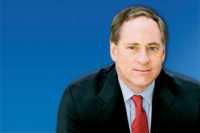
As if 2009 was not off to a terrifying enough start, Hollywood has chimed in with added terror and fear at the box office. Predicable new releases including “My Bloody Valentine” (in 3D no less), “Saw V” (as in Roman numeral ‘V’ for five in case you don’t have the first four on DVD), “The Unborn” and “Autopsy” are all coming to a theater near you. Even scarier, more shocking and threatening than any of these horror genre movies to security leaders is “Mall Cop.”
“Mall Cop” takes place in New Jersey and is the story of a failed New Jersey State Police Academy candidate who becomes a shopping mall security officer. This is when the fear and terror really begin. The organized crime gangs that target and attack the mall are not eye covering, cringing scary. No, sadly, it is the mall cop himself, who causes goose-bumps and fear.
From the fateful line, “Our mall security is fine, but ultimately we rely on the hope that nothing ever goes down” to the blood curdling scene in which he tries to arrest an elderly shopper in a three wheeled scooter, only to be dragged along the floor behind the scooter. This overweight, feeble, incompetent and at times crying mall cop presents our worse fears of a true security officer’s capabilities and image. Perhaps it raises that fear in backs of our minds that this is how our superiors and peers see our security officers.
Investment in Quality Services
Leading security departments, security companies and organizations (such as the National Association of Security Companies and ASIS International) have invested in training, standards and metrics to raise the competence and skills of the officers, the standards of service and the perception (and salary scale) of the profession. Many years and much work has gone into changing the perception that many CEOs, co-workers and other stakeholders have for security officers, which was a low one.And while it is convenient to blame Hollywood for its profiting at the expense of the profession’s image, it is probably more valuable to audit your program. Does your organization have a contract security partner that ensures the optimum image, preparation, execution and measurable outcomes?
Training and preparedness, applied technologies, metrics and measurement should be a routine component of your program. Those measurable results should be directly tied to your performance contract and your bottom line. Further, they should be a clear part of reporting to executive management.
In this year’s Annual Guard Firm Ranking report, Editor Bill Zalud takes a hard look at what makes a successful security officer program. With insightful input from Bob McCrie at John Jay College and Joe Ricci at Ricci Communications, Bill's special report gives you new management ideas and trends that show what the best are doing and how they are integrating the latest guard productivity tools. One new element: Look for SAFETY Act certification for a contract guarding firm.
Plus, several solutions-oriented case studies identify how organizations are leveraging more from their partnerships while at the same time, leading organizations are bringing more ideas to their clients to maximize the return on their security officer investment. Thankfully, none of the findings in this year’s Special Report are reminiscent of “Mall Cop.”
Updating with Convergence 2.0
The buzz word of 2006 doesn’t seem to be getting much love anymore, so it seemed the perfect time to bring it back for a fresh look. In the IT world we came to the conclusion that we stopped writing about new technology trends at about the time customers started to implement them. That appears to be the case with convergence. We are finally seeing new technologies and applications come together to improve security operations and deliver measurable productivity and bottom line benefits to users. One proof point: Analog camera sales are forecasted to decline in 2009, for the first time.In this month’s cover story, Bill Zalud interviews numerous security leaders who are realizing value from the convergence of physical and logical security systems. That includes Tony York, president, International Association for Healthcare Security & Safety; Walt Magnussen, Texas A & M University’s director of university telecommunications and associate director of the school’s Internet2 Technology Evaluation Center; EMC Corporation’s Henry Hoyt; John Petruzzi, VP Corporate Security & Emergency Management at the Simon Property Group; and Robert Messemer, CSO of The Nielson Company. Messemer cuts to the chase: “Convergence brings the opportunity for greater operational efficiency and the potential for contributions toward the organization’s profitability.”
There are many tie-ins to this month’s cover story throughout this month’s issue including features or sidebars on “Enterprise-wide Access Control Platforms” “Physical Security Information Management” and “Security Video and Analytics Converge” (there is that word again!).
I hope you find this month’s issue valuable and helpful. Please let us know at mccourtm@bnpmedia.com.
